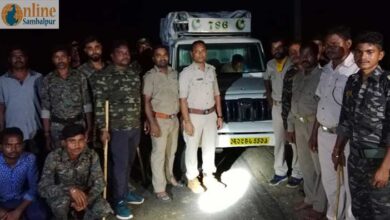Sambalpur: ‘Sindurkhela’ at Kalibari, Durga Puja is not just a puja for the Bengali community, it is an occasion of cultural union

Sambalpur: Durga Puja is not only a puja for the Bengali community, but on the occasion of Vijaya Dechamati Tithi, a day of cultural union, women pray to their mothers for the symbol of their good luck, Sindur, and wish for happiness of their husbands and family. After that, everyone celebrates by putting vermilion to each other.
This unique ‘Sindurkhela’ program has been held with enthusiasm in Kalibari, Sambalpur. Hundreds of women attended the Kalibari Pooja Mandap and participated in the event on Vijayadashmi Tithi on Wednesday. They put vermilion on each other’s heads and cheeks with a smile. This Sindoor game was very enjoyable for everyone. As Sambalpur’s first Medha, Maa Durga’s Bisorjan in Mahanadi on Wednesday Vijayadashami.
History of Sindurkhela
Sindur Khela, literally meaning ‘vermillion game’, is a Bengali Hindu tradition where women smear each other with sindur on Vijayadashami, the last day of the Durga Puja. On the day of the Vijayadashami after the conclusion of the ritual worship, married Bengali Hindu women apply sindur on the forehead and feet of the goddess and offer sweets to her. Then they put sindur on each other’s faces and offer sweets to each other.
The ritual worship of the goddess concludes with the Visarjan Puja. It is followed by Devi Baran, where the married women bid farewell to the goddess. The women are usually dressed in white saris with red borders and adorn traditional jeweleries. Each of the women perform arati and smear the goddess’ forehead and feet with sindur. They also offer her sweets and betel leaves. Following that the women smear each other’s foreheads with sindur. Then they put sindur on each other’s shankha, pala and noa, the conch shell, coral and iron bangles respectively, which are worn by the married Bengali Hindu women. Then they smear each other’s faces with sindur. Finally they offer sweets to each other as prasad.
Sindur Khela symbolizes the power of womanhood in protecting her husband and children from all evil. Through the ritual of Sindur Khela, the Bengali Hindu women pray for long and happy married lives of each other. Family tiffs and petty quarrels between neighbors are settled through this ritual. Unmarried women and widows are barred from participating in the ritual, but a recent campaign by the Calcutta Times has revived the practice of just women – be it married, widowed, transgender individuals or women of the red-light area, to play with Sindoor to show that this is a universal bonding for all women, all sisters and not restricted only to married women.
In some parts of West Bengal, Sindur Khela is celebrated before Vijayadashami. In Dubrajpur, the Sindur Khela is celebrated on Mahasaptami itself. After bathing the nabapatrika and the following ritual worship, sindur is applied on the forehead of the goddess. After that the married women engaged in Sindur Khela. In the village of Bijra near Memari in Purba Bardhaman district, the family pujas of Ghosh and Bose family celebrate Sindur Khela on Mahastami. The tradition is almost 500 years old. After the ritual worship on Mahastami, the entire married womenfolk of the village celebrate Sindur Khela. Many people from adjoining areas came to Bijra to see this ritual.





